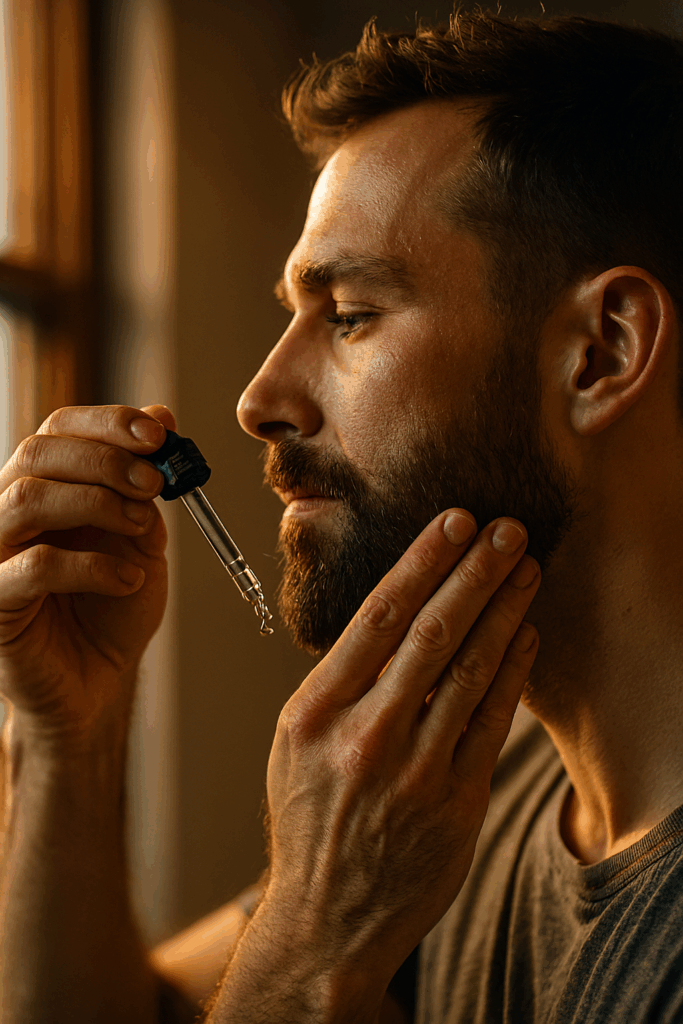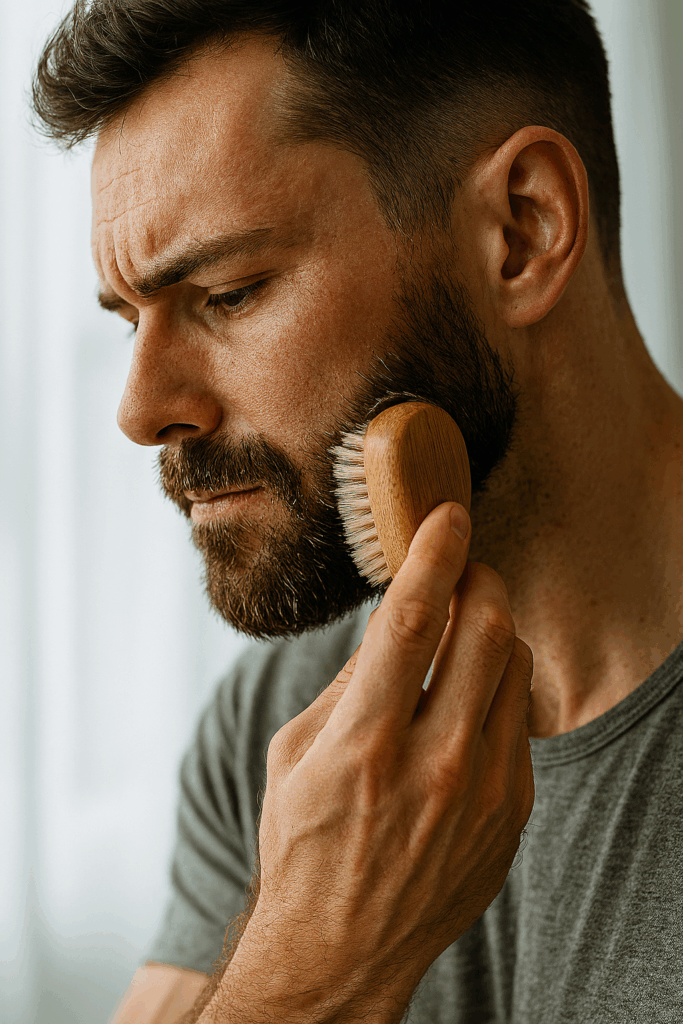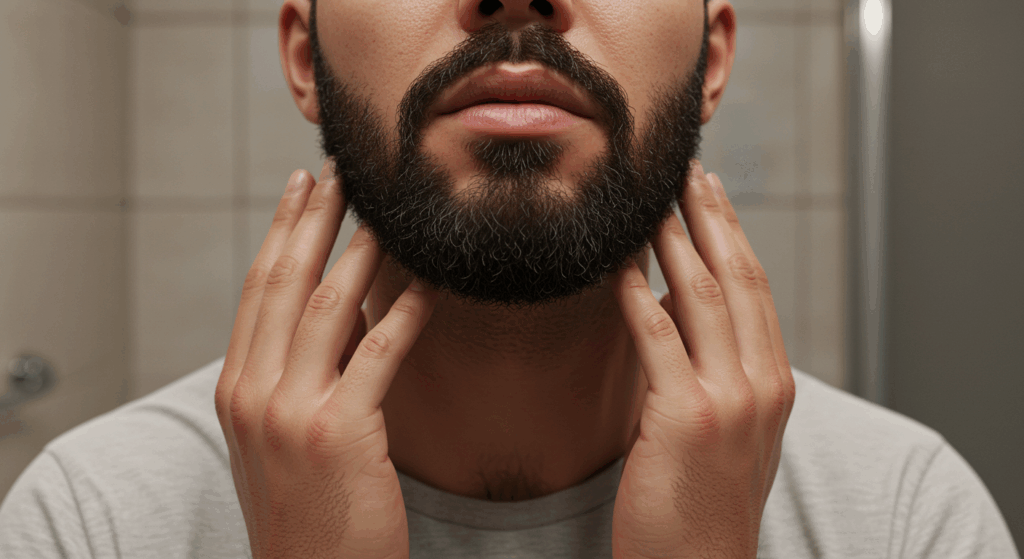Struggling with itchy, irritated skin under your beard? You’re not alone. In 2025, as more men embrace facial hair, beard area skin care has become essential for maintaining healthy, vibrant skin beneath the follicles. From razor bumps to folliculitis, managing skin issues in the facial hair region can be challenging, but with the right strategies, you can achieve smooth, irritation-free skin that complements your style.
This comprehensive guide, crafted by Dr. Ebru Okyay, a leading dermatologist in Antalya, explores everything you need to know about beard skin care. We’ll cover common problems, daily routines, treatments, and prevention tips to help you keep your facial hair region healthy and looking its best. Whether you’re growing a full beard or maintaining stubble, these insights will empower you to address skin concerns effectively.

Understanding Beard Area Skin Issues: Common Problems and Causes
The beard area is prone to unique skin challenges due to the dense hair follicles, oil production, and friction from shaving or grooming. In this section, we’ll break down the most prevalent issues affecting the facial hair region and their underlying causes, drawing from years of clinical experience at our Antalya clinic.
What Makes the Beard Area Vulnerable?
The skin under your beard is thicker and oilier than other facial areas, but it’s also trapped under layers of hair, creating a moist environment ideal for bacterial growth. Factors like sweat, product buildup, and improper grooming exacerbate problems. According to recent dermatological studies in 2025, up to 70% of men with beards report some form of skin irritation annually.
Common culprits include:
- Sebum Overproduction: Beard hair traps natural oils, leading to clogged pores.
- Environmental Factors: Pollution, humidity, and sun exposure in places like Antalya can irritate the skin.
- Grooming Habits: Harsh shaving or using dull razors causes micro-abrasions.

Top Beard Skin Issues and Their Symptoms
Let’s examine the key problems you might encounter:
| Issue | Symptoms | Prevalence |
|---|---|---|
| Ingrown Hairs | Red bumps, pain, infection risk | Common in curly hair types |
| Folliculitis | Pus-filled pimples, itching, tenderness | Affects 40% of bearded men |
| Dry Skin (Beard Dandruff) | Flaking, itchiness, scaling | Worsens in dry climates |
| Acne and Razor Bumps | Inflamed pores, scarring potential | Post-shave occurrence |
| Psoriasis or Eczema Flare-Ups | Red patches, cracking, severe itching | Chronic conditions aggravated by hair |
For more on managing chronic skin conditions like psoriasis, explore our guide on Chronic Skin Conditions.
These issues not only affect comfort but can also lead to scarring if untreated. Early recognition is key to effective management.
Building an Effective Daily Beard Skin Care Routine
A consistent routine is the foundation of beard area skin care. In 2025, dermatologists recommend a multi-step approach tailored to your skin type. At Dr. Ebru Okyay’s clinic in Antalya, we emphasize gentle, science-backed products to prevent issues before they arise.
Step-by-Step Morning and Evening Routine
Start with cleansing and end with moisturizing. Here’s a customizable routine:
| Step | Morning | Evening | Tips |
|---|---|---|---|
| Cleanse | Gentle beard wash with salicylic acid | Deep cleanse to remove buildup | Use lukewarm water; avoid hot showers |
| Exfoliate | 2-3 times/week with soft brush | Optional, if oily | Prevents ingrown hairs |
| Treat | Serum for specific issues (e.g., tea tree oil for folliculitis) | Spot treatment for breakouts | Patch test new products |
| Moisturize | Oil-free lotion or beard oil | Heavier balm for overnight repair | Choose non-comedogenic formulas |
| Protect | Sunscreen under beard (SPF 30+) | N/A | Essential in sunny Antalya |
Incorporate this routine daily for optimal results. Adjust based on whether your skin is oily, dry, or combination.
Choosing the Right Products for Your Beard Skin
Not all products are created equal. Look for:
- Ingredients: Natural antiseptics like tea tree oil, jojoba for hydration, salicylic acid for exfoliation.
- Avoid: Alcohol-based toners, heavy silicones that clog pores.
- Brands: Dermatologist-recommended options like CeraVe, The Ordinary, or our clinic’s custom blends.
For acne-prone beard areas, check our article on Conquering Acne for tailored advice.
Pro Tip: In Antalya’s climate, opt for lightweight, breathable products to combat humidity-induced sweat.
Grooming Tools and Techniques for Healthy Skin
Proper tools minimize irritation:
- Use sharp, single-blade razors or electric trimmers.
- Trim in the direction of hair growth.
- Sanitize tools weekly to prevent bacterial transfer.
Avoid over-trimming, which can cause friction burns. If fungal issues arise from shared tools, refer to our Fungal Infections Guide.
Treating Common Facial Hair Region Skin Problems
When prevention isn’t enough, targeted treatments are crucial. This section details evidence-based solutions for facial hair skin issues, based on protocols used in our Antalya dermatology practice.
Managing Ingrown Hairs and Razor Bumps
Ingrown hairs occur when shaved hairs curl back into the skin. To treat:
- Home Remedies: Warm compresses twice daily to soften skin.
- Topicals: Apply glycolic acid pads or benzoyl peroxide 2.5%.
- Prevention: Exfoliate pre-shave; consider laser hair removal for chronic cases.
- Professional Help: If infected, seek antibiotic creams or in-clinic extractions.
Severe cases may require cortisone injections; consult a dermatologist promptly.
Combating Folliculitis and Infections
Folliculitis is inflammation of hair follicles, often bacterial or fungal. Symptoms include red, pus-filled bumps.
Treatment Options:
| Type | Treatment | Duration |
|---|---|---|
| Bacterial | Antibacterial wash (chlorhexidine), oral antibiotics if severe | 7-14 days |
| Fungal | Antifungal shampoo (ketoconazole), topical creams | 2-4 weeks |
| Pseudofolliculitis | Steroid lotions, stop shaving temporarily | 1-2 weeks |
For persistent fungal folliculitis, our Fungal Infections and Skin Issues resource provides deeper insights.
Addressing Dryness and Beard Dandruff (Seborrheic Dermatitis)
Dry skin under the beard leads to flaking and itch. Hydrate with:
- Humectants like hyaluronic acid.
- Anti-dandruff shampoos with zinc pyrithione.
- Regular oiling with argan or coconut oil.
If linked to seborrheic dermatitis, prescription medicated shampoos may be needed.
Treating Acne in the Beard Area
Beard acne thrives in oily environments. Strategies include:
- Oil-control cleansers.
- Retinoids for unclogging pores (start low strength).
- Blue light therapy for stubborn cases.
Learn more about acne management in our Skin Condition: Conquer Acne post.
Handling Chronic Conditions Like Eczema or Psoriasis
For those with underlying conditions, beard hair can trap irritants. Treatments involve:
- Topical steroids under medical supervision.
- Moisturizers with ceramides to repair the barrier.
- Shaving the area temporarily for better application.
- Phototherapy sessions at specialized clinics.
Our Chronic Skin Conditions guide offers comprehensive strategies.
Advanced Tips for Long-Term Beard Skin Health and Prevention
Beyond basics, advanced strategies ensure lasting results. As a dermatologist serving patients in Antalya and beyond, Dr. Ebru Okyay recommends these for optimal beard skin care.
Lifestyle Adjustments for Better Skin
Your habits impact skin health:
- Diet: Omega-3 rich foods reduce inflammation; avoid excess dairy if acne-prone.
- Hydration: Drink 3 liters of water daily.
- Stress Management: Cortisol worsens skin issues; practice meditation.
- Sleep: 7-9 hours for skin repair.
Professional Treatments and When to Seek Help
For persistent problems, consider:
| Treatment | Best For | Cost Estimate (2025) |
|---|---|---|
| Chemical Peels | Exfoliation, acne scars | $150-300 per session |
| Laser Therapy | Folliculitis, ingrown hairs | $200-500 |
| Microneedling | Scar reduction, hydration | $250-400 |
| PRP Injections | Overall rejuvenation | $400-600 |
Schedule a consultation at Dr. Ebru Okyay’s Clinic for personalized plans.
Seasonal Care in Antalya’s Climate
Antalya’s Mediterranean weather demands adaptations: Lighter products in summer, richer moisturizers in winter. Always prioritize sun protection to prevent hyperpigmentation under the beard.
Myths vs. Facts About Beard Skin Care
| Myth | Fact |
|---|---|
| Shaving makes hair grow thicker | It doesn’t; it just appears coarser |
| Beard oil cures all issues | It’s hydrating but not medicinal |
| Men don’t need sunscreen under beards | UV rays penetrate hair; protect daily |
Debunking these ensures smarter care choices.
Conclusion
Key Takeaways
- Implement a daily routine with cleansing, treatment, and moisturizing to prevent most beard skin care issues.
- Address common problems like folliculitis and ingrown hairs promptly with targeted topicals and professional advice.
- Lifestyle factors, including diet and stress management, play a crucial role in long-term skin health.
- Consult a dermatologist for chronic or severe facial hair skin issues; early intervention prevents scarring.
Next Steps
Ready to transform your beard area? Start by assessing your skin type and building a routine. Book a virtual or in-person consultation with Dr. Ebru Okyay in Antalya to get customized recommendations. Visit our clinic website or contact us today for healthier skin under your beard.
Frequently Asked Questions (FAQs)
How often should I wash my beard?
Wash your beard 2-3 times a week with a gentle cleanser, or daily if you have oily skin or sweat a lot. Over-washing can strip natural oils, leading to dryness.
Can beard oil help with skin irritation?
Yes, beard oil with anti-inflammatory ingredients like tea tree can soothe irritation. Apply after cleansing for best results.
What causes folliculitis in the beard area?
Folliculitis is often caused by bacteria, friction from shaving, or fungal overgrowth in moist environments under the beard.
Is it safe to use acne treatments under my beard?
Yes, but choose non-comedogenic products. Consult a dermatologist to avoid irritating the sensitive skin.
How can I prevent ingrown hairs when trimming?
Exfoliate gently before trimming, use a sharp trimmer, and moisturize afterward to keep skin soft.
Does diet affect beard skin health?
Absolutely. Anti-inflammatory diets rich in fruits, vegetables, and omega-3s can reduce flare-ups.
When should I see a dermatologist for beard issues?
If home treatments don’t improve symptoms in 1-2 weeks, or if there’s signs of infection like pus or fever, seek professional help immediately.
Discover expert dermatology care with Dr. Ebru Okyay in Antalya. From beard skin care to advanced treatments, we’re here to help you achieve flawless skin. Contact us for a consultation today.
